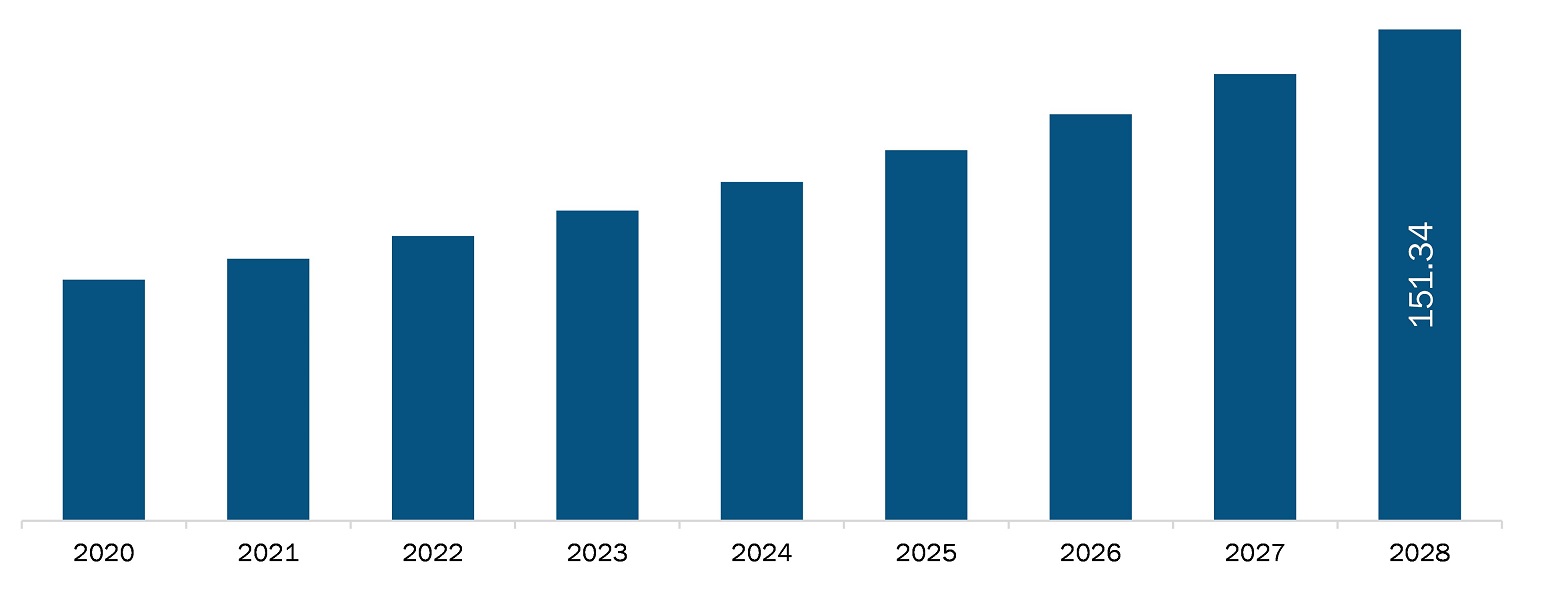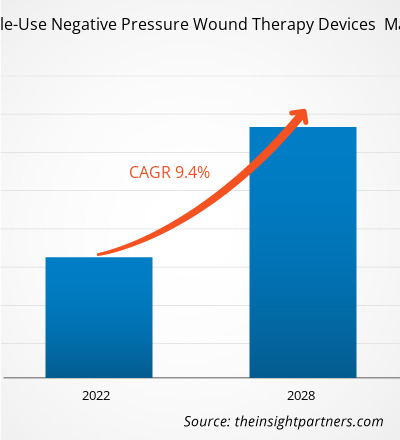The Asia Pacific single-use negative pressure wound therapy market is expected to reach US$ 151.34 million by 2028 from US$ 80.68 million in 2021; it is estimated to grow at a CAGR of 9.4% from 2021 to 2028.
The growth of the market is attributed to rising developments in the global health sector and increasing cases of burn injuries. However, the market is expected to have a slow growth rate due to the lack of effective reimbursement policies for wound care.
Chronic wound management products are an essential requirement in the healthcare sector. The research activities carried out in the last few years have resulted in innovative products and solutions in the wound management market. For instance, in February 2017, Centurion launched a new wound irrigation system, IRIG-8, for acute wound management in emergency rooms. The launch of more such innovative and effective products is expected to fuel the single-use negative pressure wound therapy devices market during the forecast period. Also, the healthcare sector has been undergoing rapid transformations from the last several years, with the growing acceptance of advanced technologies. Technology-enabled care (TEC) solutions are being adopted in emerging economies with an increase in the need for better healthcare facilities. A surge in the aging population, incidence of chronic illnesses, and advancements in pediatric care are the primary factors driving the global healthcare sector. Significant investments in R&D by various healthcare companies, governments, and research organizations and the ongoing improvements in reimbursement policies meant for various medical procedures are expected to fuel the growth of the healthcare sector in the coming years. Moreover, the increasing number of effective regulations by government bodies is likely to result in better and reliable healthcare facilities, ensuring quality care and patient safety, and mitigating fraud and cyber-threats. Such developments in the healthcare sector worldwide are likely to provide significant growth opportunities for market players for advanced wound care devices, such as single-use negative pressure wound therapy devices.
Countries in Asia Pacific are facing challenges due to the increasing incidence of COVID-19. Several measures have been implemented to contain the spread of COVID-19, which have resulted in significant operational disruption for many companies, including the companies operating in the healthcare industry. Staff quarantine, supply-chain failures, and reductions in demand have generated serious complications for companies. Also, there has been a significant drop in in-patient and out-patient for private hospital chains. To relieve healthcare systems, many clinics have been postponing diagnosis and treatment apart from COVID-19. To minimize the exposure risk during pandemic situations, patients use disposable devices rather than conventional NPWT devices. Due to health concerns, people prefer to use single-use products to manage chronic and acute wounds. This factor is supporting the growth of the market during the pandemic.

- This FREE sample will include data analysis, ranging from market trends to estimates and forecasts.
ASIA PACIFIC SINGLE-USE NEGATIVE PRESSURE WOUND THERAPY DEVICES MARKET SEGMENTATION
By Wound Type
- Surgical
- Traumatic
- Diabetic Foot
- Sports Injuries
- Venous Leg Ulcers
- Others
By End User
- Hospitals
- Clinics
- Ambulatory Surgical Centres
- Others
By Country
- China
- Japan
- India
- Australia
- South Korea
- Rest of Asia Pacific
Company Profiles
- Cardinal Health Inc
- ConvaTec Group Plc
- Carilex Medical
- Genadyne Biotechnologies, Inc.
- Lohmann & Rauscher GmbH & Co. KG
- Medela AG
- Mölnlycke Health Care AB
- PAUL HARTMANN AG
- Smith & Nephew
Asia Pacific Single-Use Negative Pressure Wound Therapy Devices Report Scope
| Report Attribute | Details |
|---|---|
| Market size in 2021 | US$ 80.68 Million |
| Market Size by 2028 | US$ 151.34 Million |
| Global CAGR (2021 - 2028) | 9.4% |
| Historical Data | 2019-2020 |
| Forecast period | 2022-2028 |
| Segments Covered |
By Wound Type
|
| Regions and Countries Covered | Asia-Pacific
|
| Market leaders and key company profiles |
- Historical Analysis (2 Years), Base Year, Forecast (7 Years) with CAGR
- PEST and SWOT Analysis
- Market Size Value / Volume - Global, Regional, Country
- Industry and Competitive Landscape
- Excel Dataset



Report Coverage
Revenue forecast, Company Analysis, Industry landscape, Growth factors, and Trends

Segment Covered
This text is related
to segments covered.

Regional Scope
North America, Europe, Asia Pacific, Middle East & Africa, South & Central America

Country Scope
This text is related
to country scope.
Trends and growth analysis reports related to Life Sciences : READ MORE..
- Cardinal Health Inc
- ConvaTec Group Plc
- Carilex Medical
- Genadyne Biotechnologies, Inc.
- Lohmann & Rauscher GmbH & Co. KG
- Medela AG
- Mölnlycke Health Care AB
- PAUL HARTMANN AG
- Smith & Nephew

 Get Free Sample For
Get Free Sample For